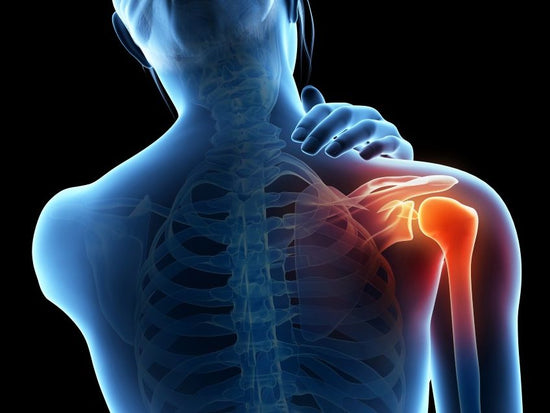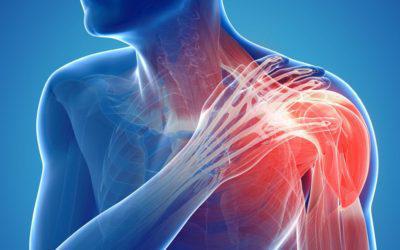WHAT TYPES OF PAIN ARE THERE?
Did you know that there are different kinds of pain? Most people with chronic pain have more than one type of pain and can even have all three. That is why looking for that one magic treatment that is going to fix everything is not always super helpful – treatment must be multi-dimensional and must be provided by an interdisciplinary team. Learn more about the types of treatment for different kinds of pain.
-

NOCICEPTIVE PAIN
Nociceptors are special receptors that respond to something that is dangerous or potentially dangerous to body structures, such as pressure, chemical changes, extreme temperatures, stretch, or when body tissues do not receive enough oxygen. Nociceptive pain is pain that is caused by actual or potential body tissue damage. It is normally related to a specific injury or event, is short lived and settles as healing occurs.
-

NEUROPATHIC PAIN
This is pain caused by lesion (damage) or disease of a nerve or a group of nerves, including peripheral nerves (any nerves outside the spinal cord), the spinal cord or the brain. It is typically burning, sharp, shooting pain, is there all the time, does not settle with normal pain medication and follows the pattern of the nerves that are damaged or diseased.
-

NOCIPLASTIC PAIN
This is pain caused by functional and structural changes to how the nervous system understands danger messages. The nervous system becomes over-sensitive and creates pain as a warning even in the absence of ongoing damage or disease.
FACTS ABOUT CHRONIC PAIN
Chronic pain can be difficult to deal with – step 1 is gaining knowledge!

FACT 1:
The intensity of the pain is NOT ALWAYS directly related to the severity of the underlying condition.
In chronic pain, your symptoms can become worse without there being anything specifically new wrong with your body. This can be very confusing and worrying. Lots of different factors can make things hurt more. One of the things that can make pain worse is increased inflammation, which can cause peaks in pain without new tissue damage.
If you are unsure, seek out a member of the interdisciplinary team. In many instances some education, simple analgesics and staying active will manage the pain.

FACT 2:
Where the pain is on your body, frequently is not where the problem is.
Nerves carry signals across long distances through the body all the way to the brain, giving it information about bits of skin and specific muscles in all the different parts of our bodies. Along the way to the brain these nerves may pass along sections of inflamed tissue, or become irritated due to pressure, stretch or problems with alignment, and the signal they carry may become scrambled. The receivers in the brain then misinterpret the signal. The brain may not understand why the signal is scrambled, what is causing the signal to be scrambled, or where along the length of the nerve the scrambling is taking place, so it does the only thing it can – it reports pain at the site that the nerve originates.
So, if you have a nerve in the neck that is irritated by pressure, you may have no or little neck pain, but severe pain in your hand, because the brain is reporting the problem of the irritated nerve in the neck, at the site where that nerve starts – the hand. Referred pain such as this needs a specialist interdisciplinary team to help make the diagnosis and recommend appropriate treatment.

FACT 3:
What you feel might be false.
Let us continue with the nerve in the neck scenario.
When the pressure is slight and the
nerve is just a little bit touchy, the signal is only slightly scrambled. The receivers in the brain struggle to make sense of it and it presents a bit like static or white noise coming from the hand...so you feel ‘pins and needles’ in your hand.
If there is a bit more pressure, and the nerve becomes really touchy and irritable, the signal can become more scrambled. The brain now becomes really worried! It starts reporting a burning, severe pain in the nerve’s distribution - the hand.
It is natural to be anxious and worried about ‘pins and needles’, and severe pain- it feels as if there is something terribly wrong with the hand, but really, it frequently is just a scrambled message from a touchy, grouchy nerve.

FACT 4:
You do not need an injury or illness to develop chronic pain.
Many people living with chronic pain do not have pain due to a specific injury, but rather due to a chronic underlying condition such as arthritis. If you already have a chronic condition, even if it is well managed, and then suffer trauma, or an injury, this could aggravate the underlying condition and be the start of your pain problem.
This may be the first time you become aware of discomfort resulting from your chronic condition and then, understandably, you might attribute the pain as resulting from the injury.
The reason this is important for you, is that if you feel that an injury caused your chronic pain, you might want someone to fix it, or be angry about what happened. You might expect someone else to fix the problem, experience more suffering, struggle to cope and rely more heavily on your healthcare providers to give you an answer.
Although these are all very normal responses, it is really important that you become an active member of your team! Studies show that passive coping strategies (e.g., taking medication, resting, using hot/cold packs, expecting others to solve the problem for you) were associated with three times as many visits to the doctor.
More importantly, it doubles the amount of pain-related disability you might experience, when compared with taking back control and using active strategies (e.g. exercise).
Chronic conditions need active management, with you as the leader of your own team.
You must take action, become an active participant in your own health journey, gather a team around you, educate yourself and become a warrior in your fight against pain.
TREATMENT OPTIONS - A COMBINATION APPROACH
-

TREATING PAIN WITH MEDICATION
Your doctor might prescribe medication to help manage your pain so that you can start making some of the other changes, like exercising more, changing your diet, or getting enough sleep.
There are different types of medication, prescribed to treat the different kinds of pain. These include anti inflammatories, analgesics (pain killers) and adjuvants (other types of medication). It is important for you to learn what your medication is supposed to do, and what the kind of pain is that it should be treating. You should also know how much of it you can and should take, and for how long, and learn about potential side effects and risks. -

THERAPY APPROACHES
Why attend rehabilitation appointments if you have chronic pain? Managing chronic pain requires an interdisciplinary approach. At PAIN the therapists you might be referred to include, but are not limited to physiotherapy, occupational therapy, biokinetics, and dietetics. The team will help you address the physical, functional, and nutritional aspects of pain, helping you lead a more active and pain-free life. Treatment provided by the therapy team is known as non pharmacological treatment, and can be effective for the management of nociceptive, neuropathic and nociplastic pain.
Learn more about physiotherapy, occupational therapy, dietetics and biokinetics, and how a combination of the right treatment options can address your unique type of pain.
-

WHEN AND WHY DO I NEED A PAIN PROCEDURE?
Pain procedures are effective to manage nociceptive pain and some aspects of neuropathic pain. These procedures are often used to treat chronic pain secondary to an underlying condition, like osteo- or rheumatoid arthritis.
Pain procedures are not effective for nociplastic pain, but if your pain is mixed, turning the volume down on the nociceptive components can give you the brain space to work on the nociplastic pain in other ways.
A pain procedure does not treat the underlying condition, but only treats the symptom of pain.
The aim of a pain procedure is to reduce your pain so that you can make the necessary lifestyle changes to manage the underlying condition. The effect is temporary, and you may need to repeat the procedure when the effect wears off, as your underlying condition that causes your pain, such as osteoarthritis, does not go away.
Fortunately, procedures that use radio frequency technology can give pain relief that lasts between 6 and 24 months.
Becoming an active member of your own treatment team, and working with your doctors and therapists to develop a plan to manage your own health can improve your outcomes and give you longer lasting pain relief from the procedure. -

SURGERY
Surgery may be one of the treatment options that your doctor will discuss with you, as some conditions do require surgical management. Read more about when you might need surgery here.
WHEN DO I NEED SURGERY?
Less than 1% of the patients that we see in our chronic pain clinics require surgery. Many of them have already had surgery elsewhere and still come to us for pain relief. The reason this happens is that there might be a reality-expectation mismatch.
People have certain misconceptions about surgery that have become urban myth.

MYTH 1: SURGERY CAN CURE BACK OR NECK PAIN
Chronic back pain and neck pain is commonly caused by osteoarthritis of the small joints of the spine. In many people, there is a genetic predisposition, which means the problem can sometimes run in families. Surgery cannot cure osteoarthritis of the spine. Surgeons can fuse the bones on either side of an affected joint which may stop the pain for a few years. However, the joints adjacent to the fusion develop osteoarthritis at a much faster pace, often leading to multiple spinal fusion surgeries and unfortunately in most patients, minimal pain relief.

MYTH 2: IT IS MY BULGING DISC THAT IS CAUSING MY PAIN
There are multiple studies that
demonstrate that a large proportion of people at all ages have bulging discs on their MRI scans without any pain at all. Therefore, merely having a bulging disc on your MRI scan is not a reason for spinal surgery and your pain is more likely to be from osteoarthritis of your spine, than your bulging disc.

MYTH 3: PINS AND NEEDLES IN MY ARMS OR LEGS MEANS THAT I AM DAMAGING A NERVE
Many people are scared that "pins and needles" in their arms or legs mean that they have nerve damage. The reality is that "pins and needles" is a very common symptom of many, many conditions, and often doesn’t mean anything important. Nerves that travel down your arm or leg can frequently be irritated by nearby inflammation in a spinal joint or from slight pressure from a disc and can be a sign of minor irritation. It may not even require any specific treatment, and will settle spontaneously most of the time. If you are concerned, your nearest interdisciplinary team will be able to investigate the cause and help you understand whether management is required.

MYTH 4: I WILL BE PARALYSED IF I DO NOT HAVE AN OPERATION
Paralysis from something other than an accident or injury is very rare. Pain that travels down the arm or leg and is severe and constant, may be an indication of pressure on a nerve, which might be due to a disc bulge. Fortunately, most of the time, this will settle with conservative management and surgery is rarely necessary. If you are concerned, your nearest interdisciplinary team will be able to investigate the cause and help you understand whether surgery is required.

MYTH 5: MY DOCTOR TESTED FOR ARTHRITIS, AND I HAVE NONE
Arthritis is a collective name for a group of conditions, some of which can be diagnosed with a blood test. Osteoarthritis is the most common type of arthritis and cannot
be diagnosed on a blood test.
X-rays, CT scans, MRI scans and radio isotope scans can help make the diagnosis, but none have 100% accuracy. At the moment, Radio isotope studies have the best success rate for accurately diagnosing osteoarthritis.
THERE ARE 3 MAIN SPINAL SURGERY INDICATIONS
1. PREVENTING PARALYSIS
Surgery is indicated in very rare, specific conditions where there is threat to multiple nerves of the spine, or the spinal cord itself and it is unlikely that the condition will self resolve, or it may be potentially unsafe to wait. Fortunately the symptoms of these conditions are normally so extreme that the person that is suffering from it, has no doubt that they should be seeking urgent medical attention.
2. CANCER
The nervous system can also develop cancerous growths and neurosurgeons specialise in doing operations to remove cancer.
3. BROKEN SPINAL BONES THAT WON'T HEAL
Like all bones of the body, the spinal bones can break. If the break does not heal properly, or is unlikely to heal on its own, surgery is sometimes indicated.
TYPES OF SPINAL SURGERY
Spinal surgery can be divided into basic types. The easiest way to understand the different types is as follows Surgery is broadly speaking designed to either take away pressure on nerves (decompressions) or to stabilise the spine (fixations, sometimes called fusion).
Decompressions
Small decompressions
Large decompressions
Fusions
In situ
Correction
Mobility procedures
Minimally invasive procedures
Endoscopic procedures
Biopsies
Resections
TREATING THE DISEASE
So, if having an operation is rarely required for chronic painful conditions, what are my options?
Well, this IS an interesting question!
Understanding the importance of looking after the whole person is critically important. Your body is the soil in which your life grows and thrives.
For life to grow and thrive, the processes and systems in your body need to be in balance. This is called homeostasis.
If the processes and systems in your body are out of balance, you will be ill.
In people who live in pain, the imbalance is caused, in a large part, by inflammation. When your body is inflamed, your systems are out of homeostasis, and you will experience pain.
Therefore restoring balance to your body is by far the most important first step.
The question is who can restore the balance in your body? Is it your doctor, your therapist,
your family, your friends, or you?
Well it is easy. Whoever is present in your life the most and has the most influence on
what you do, would be the perfect person to manage the homeostasis of your body
and systems. And that person, is you.
You are by far the most important person involved in restoring the balance to your body.
When restoring the balance of your body, the following are important:
-

DIETS AND MEALS TO COMBAT PAIN
Dieticians play a vital role in educating patients in making informed and sound decisions regarding their nutrition. There is an increasing amount of literature discussing the importance of managing our inflammation levels when it comes to pain management. This needs to be managed through lifestyle as well as diet. A dietician can help you to reduce inflammation through your diet and become more plant-focused.
-

MOVEMENT IS MEDICINE
The more pain we have, the less likely we are to move, but if we want the pain to get better, we often need to reverse the cycle. This is tricky and may require help from pain therapists, such as occupational therapists and physiotherapists, to introduce graded exercise programmes.
-

THERAPY FOR PAIN
The multimodal nature of pain requires a team to manage it and the rehabilitation therapists play a major role in disease management and symptom control.
Think of your sessions with the rehab team as visits to tour guides who will accompany you on your journey to wellness and quality of life.
Attending therapy is potentially the single most important investment you can make into your long-term health. The therapists will teach you strategies that will be useful for your entire life, not just when you have pain.
OTHER TERMINOLOGY YOU MIGHT HEAR
Referred Pain
Referred pain is pain that is felt somewhere in the body that is distant to where the actual problem is. It is normally on the same side of the body, is felt deeply and normally relates to the strip of skin or muscles supplied by a specific nerve.
Peripheral Sensitisation
Nerves outside the spinal cord or brain are known as peripheral nerves. These nerves tell your brain about every part of your body your skin, muscles, joints, ligaments, tendons and organs. When something dangerous or potentially dangerous happens somewhere in your body, your brain wants as much information as it can get – these nerves become sensitive, seeking and sending more information, faster and more loudly. This process is known as peripheral sensitisation, and is a normal part of healing.
Central sensitisation
The central nervous system (brain and spinal cord) is your body's primary alarm system. Its job is to protect you from harm. When pain has been present for a long time, the alarm system becomes over-sensitive and starts protecting you from things that are not dangerous, like normal movement and normal work. This means that you now have more pain, more frequently, and you might have pain even when you are not doing much of anything. Central sensitisation is the term used to describe what happens to the nervous system (spinal cord and brain) when it becomes over sensitive.
Endogenous Opioids
Opioids (like morphine) are some of the strongest medications we have for treating pain. Your nervous system is really good at producing its own (endogenous) morphine (opioids) when it thinks you are under threat. Exercise is one of the ways in which you can help your body produce its own morphine – this is why we say that movement is medicine!
Sensitivity to physical activity
When your nervous system is working effectively to protect you from danger,
exercise causes your brain to release happy hormones and natural morphine. When you have chronic pain, this system does not work as it should and exercise makes pain worse. This is called sensitivity to physical activity and means your nervous system is over sensitive and is not producing natural morphine. Learning how much of what kind of exercise your body needs can help you reset your nervous system and teach it to produce your own morphine again.












